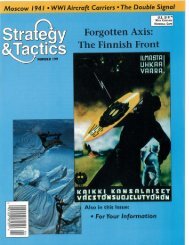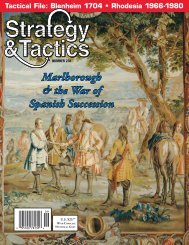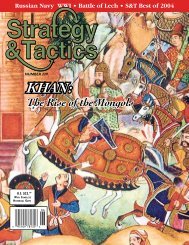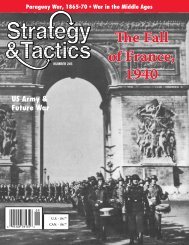the franco-prussian war - Strategy & Tactics
the franco-prussian war - Strategy & Tactics
the franco-prussian war - Strategy & Tactics
You also want an ePaper? Increase the reach of your titles
YUMPU automatically turns print PDFs into web optimized ePapers that Google loves.
I.D. will be used to plot <strong>the</strong> movement andcombat for that ship that turn.[10.121 In <strong>the</strong> next block(s), place one attackcode (if <strong>the</strong> ship is to attack in that turn) andindicate <strong>the</strong> Unit I.D. of <strong>the</strong> target ship. If aship is to make both gunnery and torpedoattacks in a given turn, <strong>the</strong>n two attack blockswill be required.110.131 Following <strong>the</strong> blocks in which attackshave been recorded (if any) plot <strong>the</strong> movementof each unit, recording each hex to be enteredby <strong>the</strong> unit in this turn. If <strong>the</strong> unit will expendmovement points turning in a particular hex,place a circled number in <strong>the</strong> block with <strong>the</strong>hex number to indicate how many movementpoints were expended in turning. See (6.0)Movement for details on how to move.I10.141 After all of <strong>the</strong> movement points of <strong>the</strong>unit have been expended, in <strong>the</strong> next block,place <strong>the</strong> final speedifacing of <strong>the</strong> unit, i.e., <strong>the</strong>speed facing after completion of all turning,acceleration, deceleration, etc.; this becomes<strong>the</strong> initial speedifacing for <strong>the</strong> next turn.I10.21 ATTACK CODES[10.211 An attack code written in a block with aUnit I.D. commits <strong>the</strong> given ship to make <strong>the</strong>indicated type of attack on <strong>the</strong> indicatedtarget. The attack codes are "G" for gunneryattacks and "T" for torpedo attacks. Attacksare made subject to <strong>the</strong> limitations ofsection (7.0).[10.221 Decisions regarding combat are final.No changes in attacking units or target unitscan be made after <strong>the</strong> end of <strong>the</strong> OperationPlot Phase.[10.31 SECRECY AND HONESTYEach player's Simultaneous Movement PlotChart is to be hidden from <strong>the</strong> o<strong>the</strong>r playeruntil <strong>the</strong> end of <strong>the</strong> game. If <strong>the</strong>re is anyquestion about <strong>the</strong> o<strong>the</strong>r player's orders, <strong>the</strong>Player is advised to write <strong>the</strong>m down andcompare <strong>the</strong>m with <strong>the</strong> SMS Plot Chart at <strong>the</strong>end of <strong>the</strong> game. A player who secretlyviolates <strong>the</strong> rules to gain an advantage in <strong>the</strong>game, forfeits that game.[10.41 SIMULTANEITY OF COMBAT[10.411 All combat is considered simultaneous.For this reason Combat Results are noteffective until <strong>the</strong> Combat Results ApplicationPhase. Then <strong>the</strong>y are applied to all units thatsuffered <strong>the</strong>m.[10.421 A ship that suffers a Combat Result in agiven Combat Resolution Phase must engagein combat in that phase if ordered to do so by<strong>the</strong> SMS Plot Chart without any considerationof <strong>the</strong> Combat Result. The Combat Resultdoes not affect <strong>the</strong> ship's combat ability in anyway until <strong>the</strong> Combat Results ApplicationPhase of that turn.[10.51 SIMULTANEITY OF MOVEMENTAll movement is also considered simultaneous.Both players execute all plotted movementduring <strong>the</strong> Board Movement Phase. All plottedmovement must be executed; ships may neveralter <strong>the</strong>ir movement in response to enemyactions.l7.61 SMS NIGHT TIME SPOTTING[7.61 I Most scenarios in "CA" take place atnight. There are special restrictions upon firingat ni~ht Shins may only fire guns or torpedosat target ships that are "spotted."[7.621 Spotting occurs in three manners:(a) Whenever a ship uses its Gunnery Strengthin a turn, place a spotted marker on it. Torpedoattacks do not cause spotting.(b) Whenever a ship is within eight (8) hexes ofan enemy ship, place a spotted marker on it.(c) Whenever a ship has been <strong>the</strong> target of agunnery attack in a turn, and fulfilled <strong>the</strong>conditions (a) or (b) above, it remains spottedfor <strong>the</strong> following Game- Turn only, if it is againunder under gunnery attack, even though itdoes not fulfill <strong>the</strong> requirements of (a) or (b).I7.631 Spotting is determined only in <strong>the</strong> SightDetermination Phase. Ships which fulfill <strong>the</strong>sighting requirements in that phase, and shipswhich make gunnery attacks (see 10.31) arespotted for that turn. Because spotting is onlydetermined in <strong>the</strong> sight determination phase,<strong>the</strong> initial contact between two ships may bemade at less than eight hexes.I7.641 Spotted markers are removed at <strong>the</strong> endof each Game-Turn.Those are all <strong>the</strong> rule changes necessary toplay "CA" in Simultaneous Movement. Forthose players willing to put up with some slightadditional complexity, <strong>the</strong> SimultaneousMovement System can be used to add acrucial factor to <strong>the</strong> game - <strong>the</strong> simulation ofpreparednesslalertness, which is crucial in allnaval combat, but is particularly important atnight. The method for doing this will bediscussed in a later article if feedback response<strong>war</strong>rants it.Shown, is an example of how to fill out <strong>the</strong>SMS Plot Chart as indicated in <strong>the</strong> rules.SPI SIMULTANEOUS MOVEMENT PLOTTING CHARTi.r*gnl 1973 snn~utn~-.amsknr ~.r rolr. NVUNIT MOVEMENT PLOT ,YE, J-Indicated is <strong>the</strong> first turn plot for <strong>the</strong> AlliedPlayer in Scenario 1A. In this case, <strong>the</strong> first hexof placement is written down because <strong>the</strong> twocapital ships expend <strong>the</strong>ir Movement Pointsturning in this hex; o<strong>the</strong>rwise this hex wouldnot be written down, as <strong>the</strong> information isgiven with <strong>the</strong> scenario The two capital shipsattack <strong>the</strong> IJN BC's, though <strong>the</strong> combat isineffective because of <strong>the</strong> range (it is merelyincluded to show <strong>the</strong> mechanics). No torpedoattacks are made this turn. The Allied Playerincreases <strong>the</strong> speed of all his ships, andmaneuvers to close <strong>the</strong> range.Qp$'JQAddingThe "CA" article was a relatively well donetreatise on <strong>the</strong> fighting around <strong>the</strong> Solomons.Unfortunately, <strong>the</strong>re were a large number oferrors in <strong>the</strong> article and associated descriptivemodules, some trivial, some technical, andsome just downright erroneous research.O<strong>the</strong>r than <strong>the</strong> following items, <strong>the</strong> articlecovers a subject too often overlooked andconsidering what you attempted to do with <strong>the</strong>game, you achieved a fair measure of success.ERRA TA:A. MAIN ARTICLE1. Pg. 12. Although IJN training exercises wereconducted under much more rigorous andrealistic conditions, <strong>the</strong>ir quartermasters wereno less parsimonious about lost torpedoesthan were ours. Cmdr Hara, Japan's leadingtorpedo expert, states that due to <strong>the</strong> cost andsecurity considerations, units would spendmany hours searching for just one straytorpedo and that practices were often calledoff due to bad wea<strong>the</strong>r and fear of losing anerrant torpedo.2. In <strong>the</strong> same paragraph, mention is made ofsinking obsolete <strong>war</strong>ships. The USN alsoconducted exhaustive tests, sinking <strong>the</strong>uncompleted 4th unit of <strong>the</strong> Maryland Class(USS WASHINGTON 8847) off VirginiaCapes 25/11/24 as well as OSTFRIESLANDand numerous o<strong>the</strong>r <strong>war</strong>ships. These testswere quite meaningful and aided considerablyin <strong>the</strong> design development of subsequentvessels.3. In numerous discussions of <strong>the</strong> Japaneseand <strong>the</strong>ir cruiser development, critics parrotMorrison's sentiments that IJN heaviesexceeded treaty limits by gross amounts thusproducing such superior ships. In fact, <strong>the</strong> first4 CA's, Hirago's Aoba Class were well belowtreaty limits, <strong>the</strong> Myokos displaced 10,940 tonswhile <strong>the</strong> Atogos were only 410 tons heavier.Now <strong>the</strong>se figures certainly do not indicate anygross attempt to circumvent treaty obligations.Now after <strong>the</strong> treaty expired in 1935 all fourMyokos and two of <strong>the</strong> Atagos wereextensively rebuilt bringing <strong>the</strong>m up to 13,380and 13,400 tons repsectively, but this was onlyafter <strong>the</strong> treaty expired. Noting that after all<strong>the</strong>se many years <strong>the</strong> facade of our 35,000 ton"treaty" battleships has been finally lifted, itwould not surprise many people if exhaustiveresearch into US treaty cruisers' actualdisplacements might also reveal some eyeopening information.4. Pg. 16. Ano<strong>the</strong>r mistaken notion which hasbeen perpetuated by numerous writers is increditing Imperial Navy Headquarters with <strong>the</strong>first widespread acceptance of <strong>the</strong> carrier as<strong>the</strong> capital ship of World War II, which is reallynot <strong>the</strong> case. Kido Buntai was an untriedweapon system whereas Senkan Sentai were<strong>the</strong> acclaimed Queens of <strong>the</strong> Sea. In fact <strong>the</strong>carriers were considered more expendablethan battleships early in <strong>the</strong> <strong>war</strong>. It was notreally until after Midway that Rengo Kantaiwas willing to begin to accept <strong>the</strong> precept that<strong>the</strong> "decisive battle" would be fought in <strong>the</strong> airover <strong>the</strong> ships and not by <strong>the</strong> battle line. In facta special paper entitled, Reserach On StrikingForce <strong>Tactics</strong>, written by Yokosuka Naval AirGroup in May 1943, makes considerablemention of this as if <strong>the</strong>y were trying topersuade higher headquarters as to <strong>the</strong> deathof <strong>the</strong> battleship as capital ship. At any rate <strong>the</strong>objective of Pearl Harbor was to remove <strong>the</strong>Pacific Fleet as an obstacle to <strong>the</strong> conquest of<strong>the</strong> Greater East Asia Co-Prosperity Sphere. . .an objective which in EVERY way was fulfilled.The original strategic plan was to occupy <strong>the</strong>necessary territories, consolidate an outerdefensive perimeter and <strong>the</strong>n sit back and waitfor <strong>the</strong> US to spend itself on <strong>the</strong> outer portionsof that perimeter. As our good fortune wouldhave it, "victory fever" set in causing <strong>the</strong>Japanese to overextend <strong>the</strong>mselves and as aresult being defeated at Coral Sea andMidway. Had <strong>the</strong>y struck to <strong>the</strong>ir original plan







